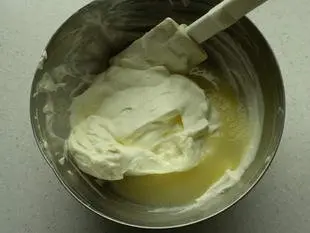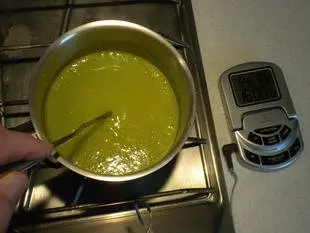This site uses only a few technical cookies necessary for its operation. By continuing to browse, you accept their use.
To find out more...
To find out more...
Fruits which can ruin your jelly

There are many ways of making a fruit mousse, but one of the simplest is to prepare a fruit jelly (basically a fresh fruit coulis with gelatine) and then mix this jelly before it sets completely with whipped cream.
The result is perfect for filling a charlotte, for example.
But do beware; there are some fruits for which this will not work: kiwis, pineapple, mango and figs, in particular. You can add any amount of gelatine you like and the jelly will never set!
The result is perfect for filling a charlotte, for example.
But do beware; there are some fruits for which this will not work: kiwis, pineapple, mango and figs, in particular. You can add any amount of gelatine you like and the jelly will never set!
78 K 4.0/5 (32 reviews)
Keywords for this post:JellyGelatinMousseFruitKiwiLast modified on: March 6th 2013
Fruits which can ruin your jelly
And it can't set because these fruits contain enzymes called proteases, such as bromelain or papain, which prevent the gelatin from setting. So you cannot just make a straightforward kiwi or pineapple jelly.
Fortunately, science comes to the rescue and explains that it is possible to neutralise the effects of these bothersome proteases. We call this denaturing. All that is necessary is to heat the fruit to 60°C.
So, to make a pineapple jelly, for example, you simply need to heat the coulis over low heat to 60°C, add the gelatine, then leave to cool.
Even so, you should note that for a kiwi jelly, you should take care not to overheat the coulis if you wish to preserve the lovely green colour of the fruit. If it is overheated, the colour will turn dull, then brown. A thermometer is essential to ensure that the right temperature is reached but not exceeded.
As a last resort, you can use another jelling agent, such as carragheen.
Fortunately, science comes to the rescue and explains that it is possible to neutralise the effects of these bothersome proteases. We call this denaturing. All that is necessary is to heat the fruit to 60°C.
So, to make a pineapple jelly, for example, you simply need to heat the coulis over low heat to 60°C, add the gelatine, then leave to cool.

Even so, you should note that for a kiwi jelly, you should take care not to overheat the coulis if you wish to preserve the lovely green colour of the fruit. If it is overheated, the colour will turn dull, then brown. A thermometer is essential to ensure that the right temperature is reached but not exceeded.
As a last resort, you can use another jelling agent, such as carragheen.
Lasts posts
Butter vs. grease
We often read in a recipe where a pastry is put into a mould that, just before pouring, the mould should be buttered or greased. But what's the difference between these 2 terms?December 1st 20257825
Getting out of the fridge early
Very often when you're cooking, you need to take food or preparations out of the fridge, to use them in the recipe in progress. There's nothing tricky about this: you just take them out of the fridge and use them, usually immediately, in the recipe. But is this really a good method?November 24th 20251,0085
Who's making the croissants?
When you look at a bakery from the outside, you naturally think that in the bakery, the bakers make the bread, and in the laboratory, the pastry chefs make the cakes. It's very often like that, with each of these professions having quite different ways of working, but sometimes there's also one...November 23th 2025906
Oven height
When we put a dish or cake in the oven, we naturally tend to put it on the middle shelf, and that's what we usually do. But in some cases, this position and height can be a little tricky, so let's find out why.October 8th 20252,5295
The importance of sieving
In recipes that use a fine powder (flour, powdered sugar, etc.), you'll often see the advice to sift before using it. To sift is to pass the powder in question through a sieve (a very fine strainer) before incorporating it into your recipe. It's often advice, but is it really useful?September 3rd 20257,3913
Other pages you may also like
Candied fruits: don't get ripped off
Do you like candied fruit? You might like to nibble a handful or add it to a recipe, like a classic fruit cake or delicious Italian specialities like panettone or sicilian epiphany pie.June 21th 201767 K 24.2
The super powers of cornstarch
I start this new year by evoking an old product, that you most probably have in your cupboards, a white powder, often in a small cardboard package with a slightly outdated look, only the "gluten free" is relatively recent, it is simply cornstarch, hence its name of maïzena. It's used for a lot...January 14th 202215 K
What is the difference between bakery and patisserie?
This is a question that you may well have asked yourself and which I will attempt to answer. In France the two trades of "boulangerie" (bakery) and "pâtisserie" (patisserie and confectionery) have always been quite distinct, but where exactly do the boundaries lie? .February 7th 2017134 K 14.1
How to avoid lumps
You've probably come across this unpleasant phenomenon where, when you try to incorporate an ingredient (usually a solid or powder) into a preparation (usually a liquid), the mixture doesn't mix properly and you end up with little "balls" or little lumps of the solid part that refuse to mix with the...October 9th 202022 K4.8
The window-pane test in bread-making
The home bread-makers often ask themselves “Have I kneaded my dough long enough?” . A good question, as dough that is insufficiently kneaded will not rise properly or will fall flat when the top is slashed, which is very frustrating. To know when the dough is ready, one can rely on the length...June 16th 202196 K 23.9
Post a comment or question
Follow this page
If you are interested in this page, you can "follow" it, by entering your email address here. You will then receive a notification immediately each time the page is modified or a new comment is added. Please note that you will need to confirm this following.
Note: We'll never share your e-mail address with anyone else.
Alternatively: you can subscribe to the mailing list of cooling-ez.com , you will receive a e-mail for each new recipe published on the site.









